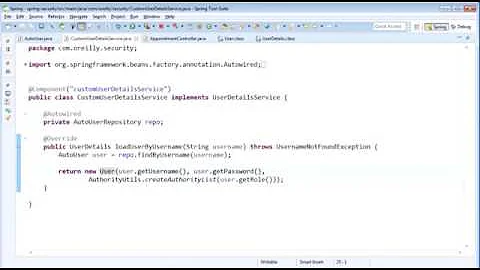SecurityContextHolder.getContext().getAuthentication() returning null
Solution 1
So, I found the actual problem! The issue was that I had marked the whole controller with security="none" in the security-context.xml. So, when it was bounced from the first link to the 2nd, it didn't pass any security context with it!! Sorry for the trouble, guys.
Solution 2
Additional Answer: If you want to get logged-in user details for a non-secured url then you can add them to secured urls and assign as "permitAll" like this:
<http>
//...
<intercept-url pattern="/your/url/**" access="permitAll"/>
//...
</http>
Then, you will be able to check the logged-in user if logged-in or get the credentials.
Solution 3
Your localUser is null.So the auth become null.So no authentication object has been added to the security context.
Please have look at the doc
It is better to have a customUserDetailsService
public class CustomUserDetailsService implements UserDetailsService
//implement the method which return a UserDetails Object
public UserDetails loadUserByUsername(String username) throws UsernameNotFoundException
then you can use
UserDetails userDetails= customUserDetailsService.loadUserByUsername("name");
Authentication authentication= new UsernamePasswordAuthenticationToken(userDetails, null, userDetails.getAuthorities()) ;
SecurityContextHolder.getContext().setAuthentication(authentication);
Related videos on Youtube
Rajesh Wadhwa
Updated on July 10, 2022Comments
-
Rajesh Wadhwa almost 2 years
I want to manually bypass the user from spring Security using the following code:
User localeUser = new User(); UsernamePasswordAuthenticationToken auth = new UsernamePasswordAuthenticationToken(localeUser ,null, localeUser .getAuthorities()); SecurityContext securityContext = SecurityContextHolder.getContext(); securityContext.setAuthentication(auth); // Create a new session and add the security context. HttpSession session = request.getSession(true); session.setAttribute("SPRING_SECURITY_CONTEXT", securityContext); return "dummyLogin";The dummy login page(handled by tiles)internally calls a different Request Mapping in the same controller where i am trying to get the Authentication something like this.
SecurityContextHolder.getContext().getAuthentication()Where i am getting null?
-
 Selva about 10 yearsYou are passing an empty User object to UsernamePasswordAuthenticationToken constructor. May be that is the reason you are getting null.
Selva about 10 yearsYou are passing an empty User object to UsernamePasswordAuthenticationToken constructor. May be that is the reason you are getting null. -
 Dave Syer about 10 yearsAlso a null password (I think that's also illegal). Maybe if you show the stack trace?
Dave Syer about 10 yearsAlso a null password (I think that's also illegal). Maybe if you show the stack trace? -
hi_my_name_is about 10 yearspassword can be null, I would rather check if session is the same after you create it and in code which run getAuthentication. Log your session.getId() to check it.
-
 Jay about 10 yearsDo you want to bypass the security only for some particular pages or particular user or for all ?
Jay about 10 yearsDo you want to bypass the security only for some particular pages or particular user or for all ? -
Rajesh Wadhwa about 10 yearsI want to bypass for all the pages for that particular session Id(User)
-
Rajesh Wadhwa about 10 yearsAlso i checked the session ID in both the requests !its the same.Cant get the problem
-
-
Rajesh Wadhwa about 10 yearslocalUser is not null!.its a custom user object of the application which on initialization self created the Ids and Details in it.
-
 Andrei Suvorkov almost 6 yearsYou don't have to comment it. Instead could you add your commnet to answer
Andrei Suvorkov almost 6 yearsYou don't have to comment it. Instead could you add your commnet to answer -
Asraful over 5 yearshelped me to solve my issue , i put certain url pattern in ignore configuration , and result is null security context in those controller , removing from ignore configuration makes this controller as secure , eventually get the security context as desired
-
testing_22 almost 2 yearsThe first sentence is so right on point in my case. It should be highlighted







![Security Context in Spring Security (Part-1) | Multiple Authentication [Hindi] | #09](https://i.ytimg.com/vi/mLMZ_LXnYzQ/hq720.jpg?sqp=-oaymwEcCNAFEJQDSFXyq4qpAw4IARUAAIhCGAFwAcABBg==&rs=AOn4CLAzKGAEpXBDLwCKmqfQ73MAgtFftw)